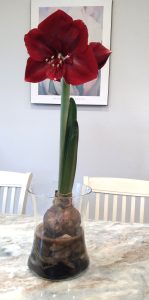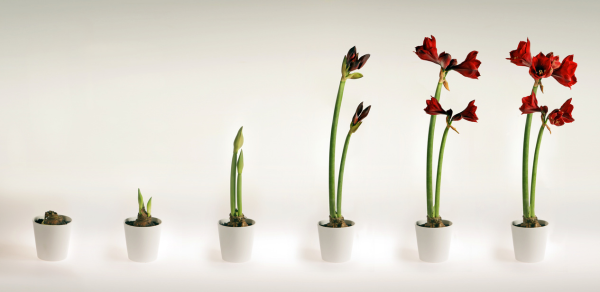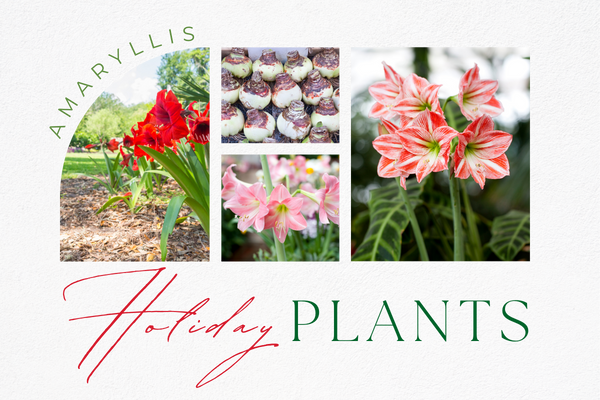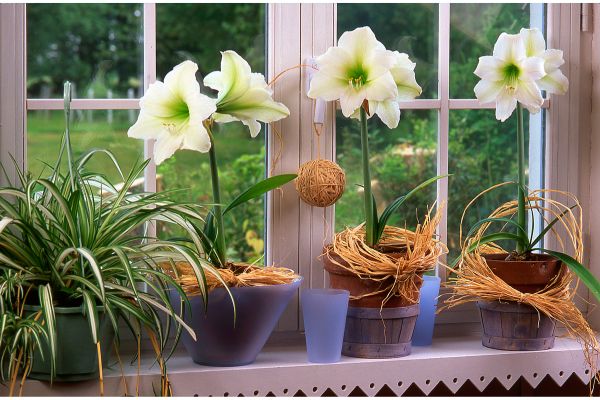 Amaryllis for the Holidays and Beyond
Amaryllis for the Holidays and Beyond
It’s about time to start decking those halls! I love using natural materials and plants as holiday décor, and one plant known for merry and bright is the amaryllis. The amaryllis we buy for our homes and landscapes are hybrids and the genus name is Hippeastrum. They are in the family Amaryllidaceae, which includes amaryllis, agapanthus, crinum, narcissus, daffodil, clivia, leeks, garlic, and onions. (This is why so many gardeners get confused between an amaryllis, agapanthus and crinum – the bulbs ARE similar!)
How To Grow
Amaryllis bulbs can be found at nurseries this time of year ready to bloom in weeks instead of months. This is because they have been through a forced dormancy to prepare them to put on new shoots and flowers just in time for holiday gift-giving. If you are the lucky recipient of an amaryllis bulb, it may come with a kit including a pot and soil. If not, they are very easy to pot up in any container with drainage holes and standard potting soil. Be sure not to bury the bulb too deeply. Leave the top 1/3-1/4 of the bulb sticking up above the soil. Water the soil thoroughly and place in a sunny spot.
Another attractive way to grow the bulb indoors is to force it in water. I use a large clear vase with attractive pebbles or marbles filling the bottom third to half of the container. Sit the bulb on top of the rock layer. You may have to use a couple rocks to help the bulb stand upright. Then fill the vase with water right up to the top of the rocks/base of the bulb. You don’t want the bulb itself underwater. Instead, the water should barely touch the bottom of the bulb. The bulb will soon start to grow nice, white roots all through the rock layer. Blooming will quickly follow.
After the flowers fade, cut the flower stalk off before the seed pod forms, and then either keep inside as a potted plant or plant in the landscape in a slightly shady spot.
Blooming
The ideal time to plant the bulb in Florida is between September and January. Do not remove the foliage until it turns brown. The bulb will store energy from the leaves as they fade to use as fuel for the next season. Amaryllis are spring bloomers in the landscape, but it may take a year off for the bulb to get back in sync and bloom after going through the forced dormancy and winter bloom.
Wax-dipped
Wax-dipped amaryllis bulbs have become popular gift items in the last few years. You can find them looking like Christmas tree ornaments with the bulbs completely coated in thick wax in red, gold, green, and many other decorative colors. If you purchase or receive a wax-coated bulb, all you have to do is sit the bulb on the mantle and enjoy. It requires no soil or water and to bloom. The bulb has already stored everything it needs to push out leaves and flowers. Amaryllis bulbs are such reliable bloomers that back in Victorian times when window glass was murky and indoor lighting was severely lacking, they could still be found being forced for winter blooms in chilly parlors. Some sites online suggest tossing the waxed bulbs after the flowers fade, but you can carefully peel away the wax and the cellophane underneath to free the bulb. The roots will have all been cut off before getting the wax dip, so I suggest potting up the bulb in a container for a month or more to get new roots growing before planting in the landscape.
Amaryllis Beyond the Holidays
– In the Garden
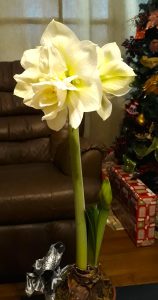
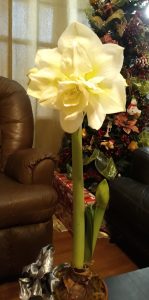
Amaryllis look best in the landscape planted in a grouping instead of a straight line. There are many colors to choose from including pink, red, white, and orange. There are solid color varieties and striped flower varieties. There are single flowering amaryllis and double flowering amaryllis. My personal favorite is a double flowering white called ‘Marilyn’. She is a show-stopper.
– Propagation
Propagation is by division or seed. To divide, lift the bulb and separate the bulblets from the mother plant in the fall. From seed, it can take three years to get to a flowering plant. And the new plant may not look like the parent plant.
– Pests
Unfortunately, lubber grasshoppers consider these a treat, as they love all plants in the Amaryllidaceae family. Take care around pets and children as ingesting amaryllis will make them sick.
Last year, around this time, my husband came home from the nursey with a fat bulb in a brown bag for me. It gave me so much joy to watch it grow leaves and flowers on my kitchen counter. I’m hoping for another brown bag soon!
This post is written by Duval County Extension agent, Tonya Ashworth. For more information about growing flowers from bulbs, please follow this link: https://edis.ifas.ufl.edu/topics/bulbous_flowers Many of master gardener volunteers grow huge patches of agapanthus and crinums. You can find impressive displays at both Beach Heritage Gardens and at Mandarin Garden Club.
Source: UF/IFAS Pest Alert
Note: All images and contents are the property of UF/IFAS.

